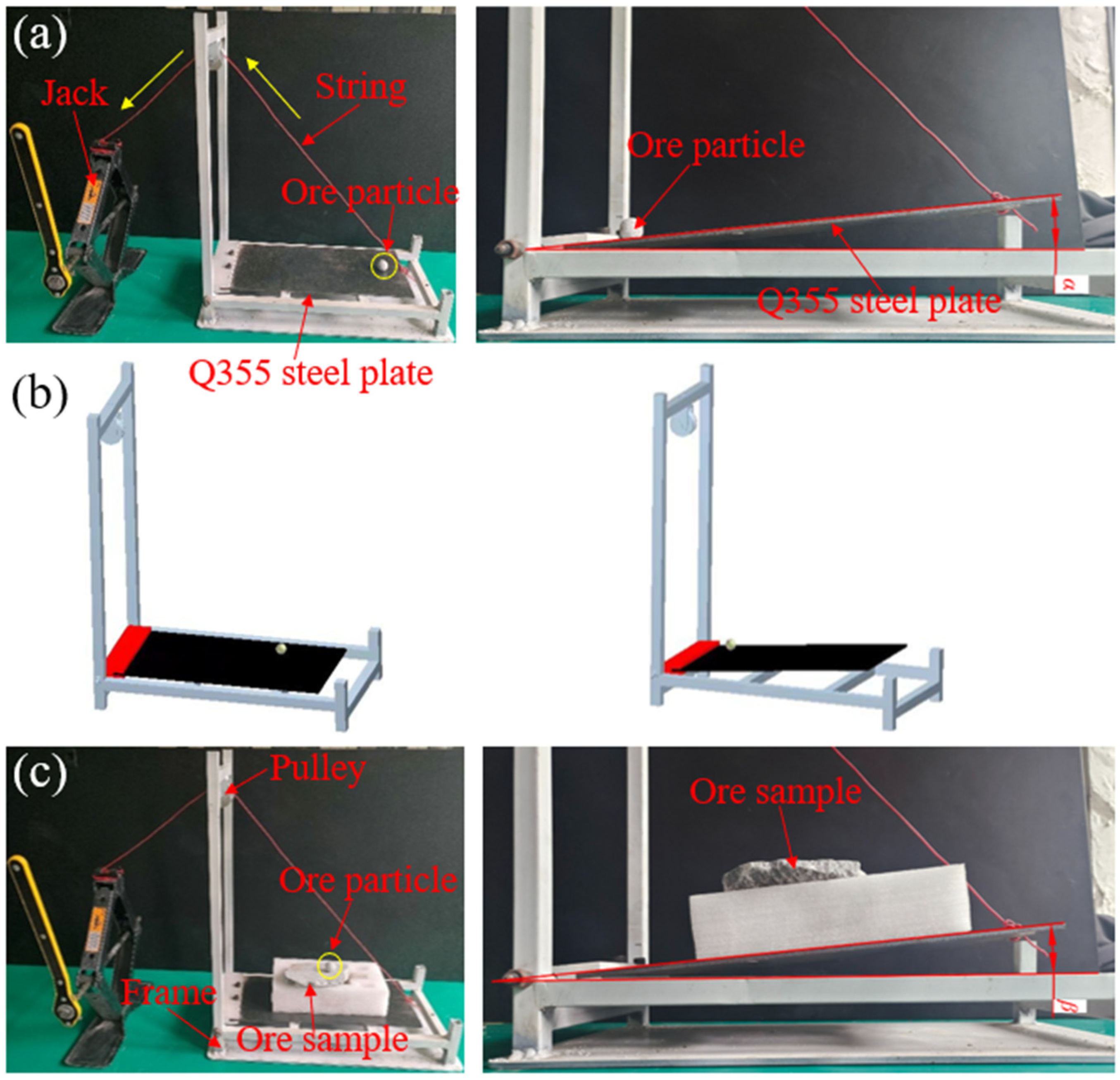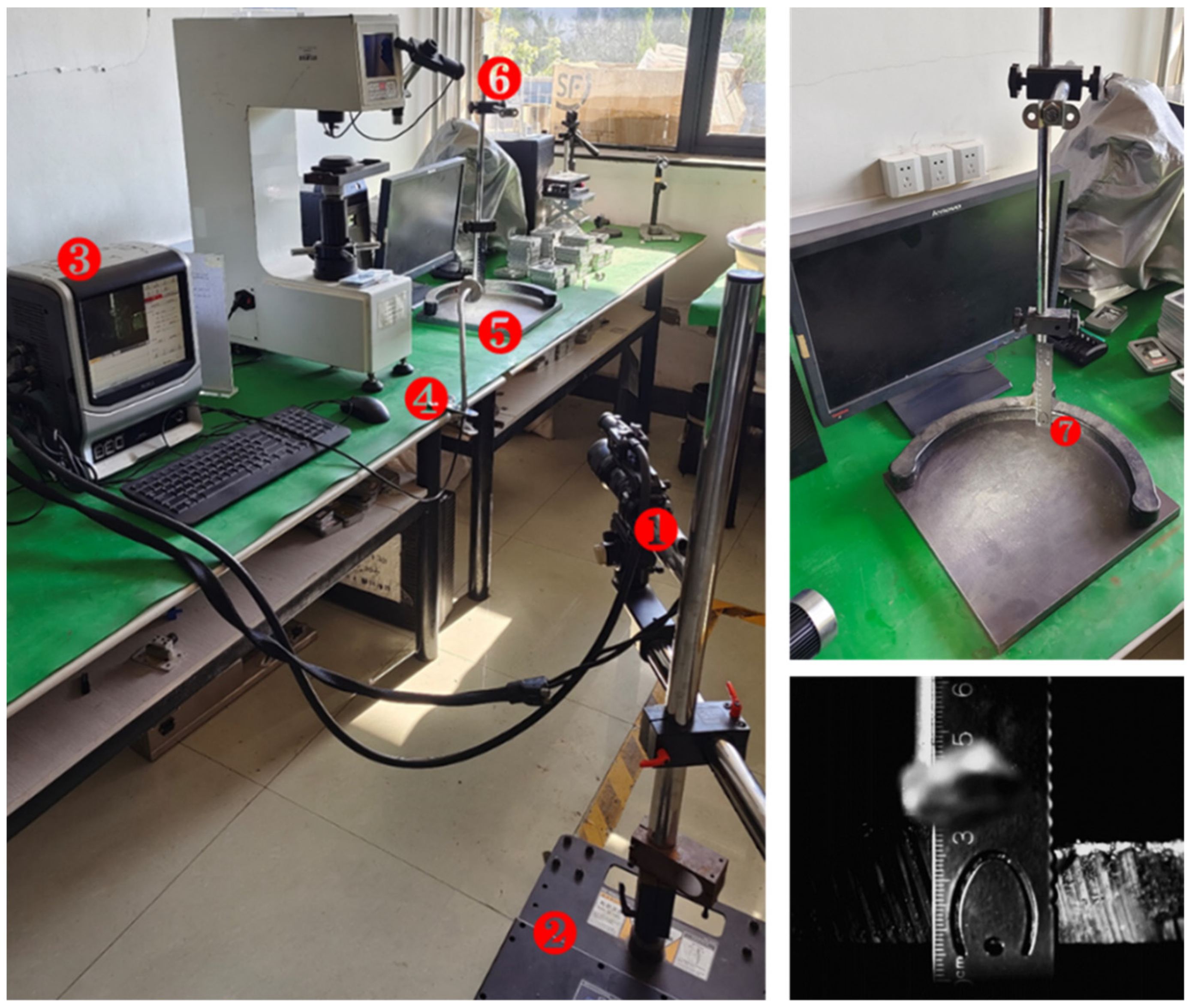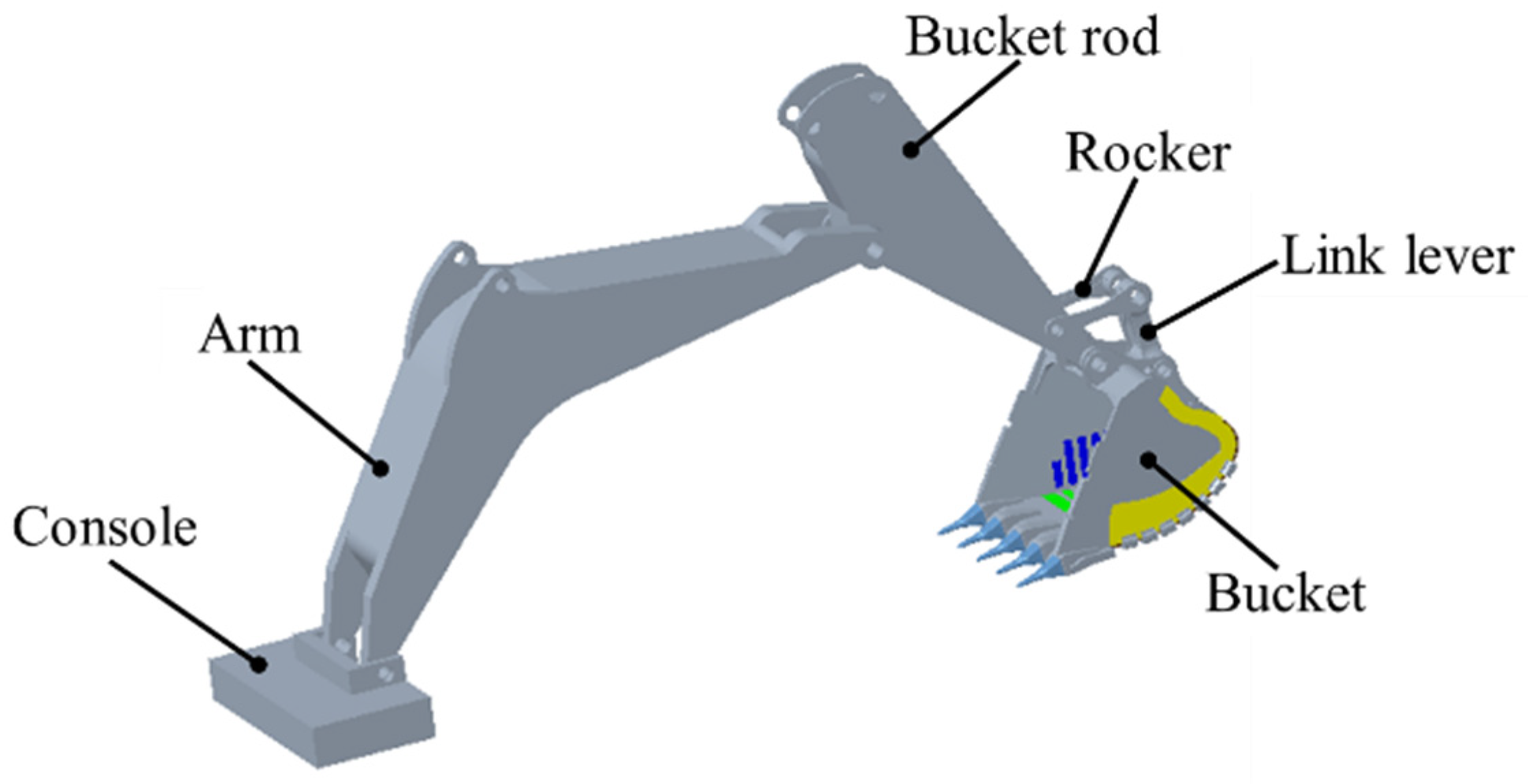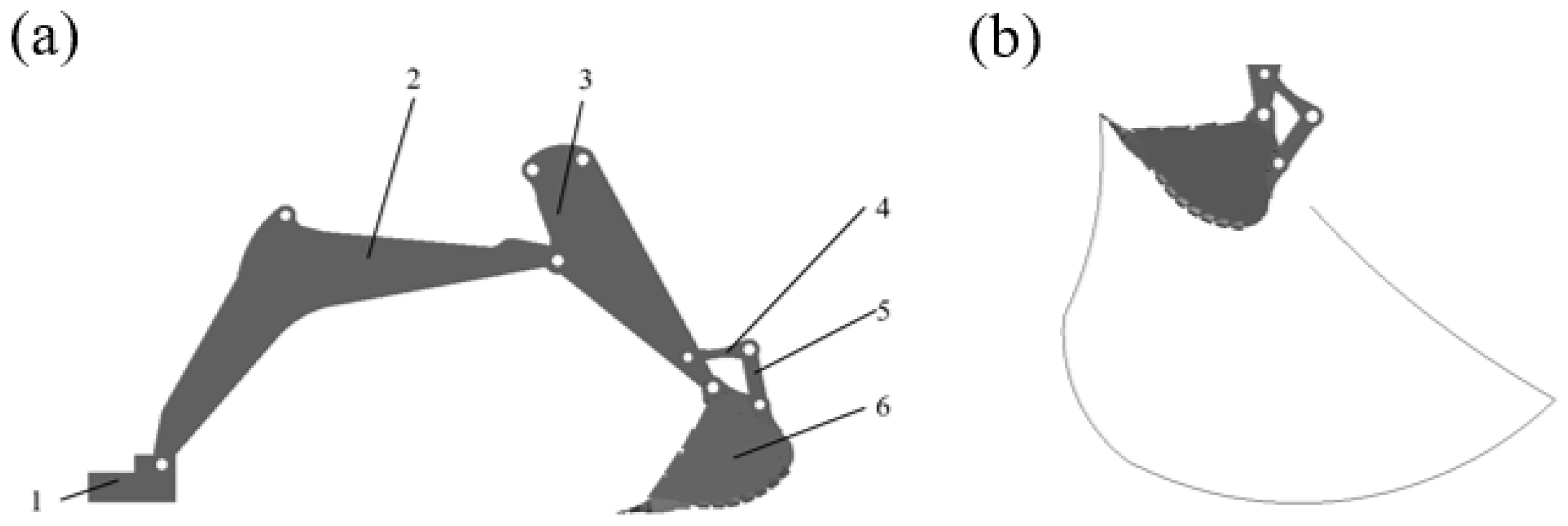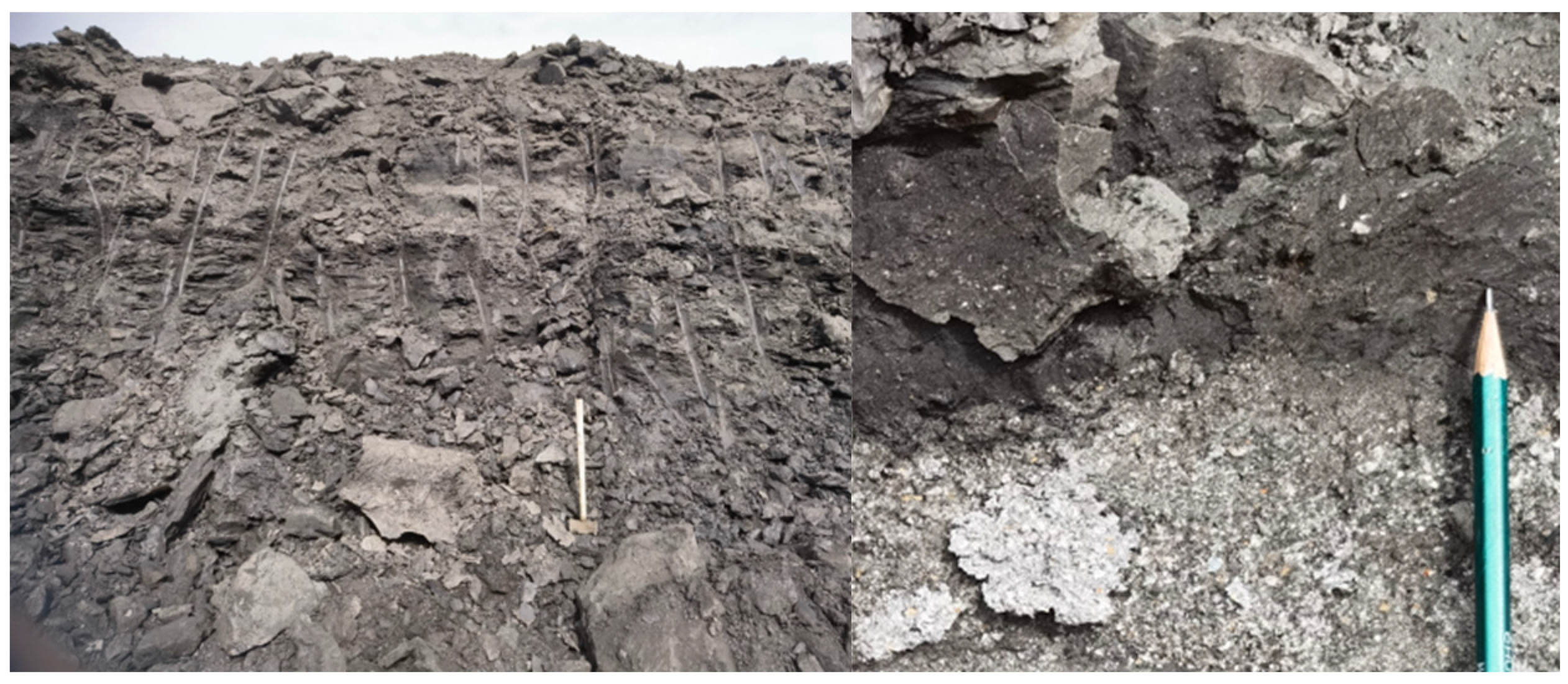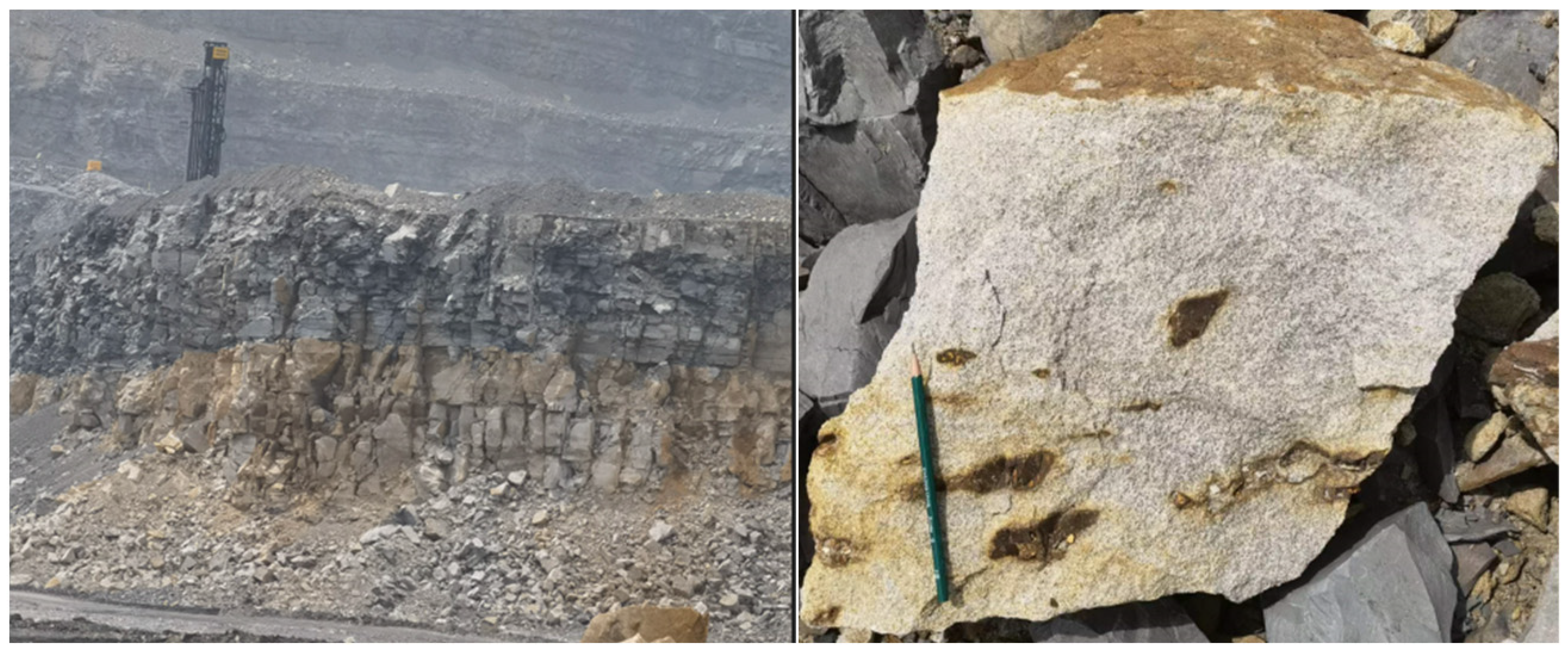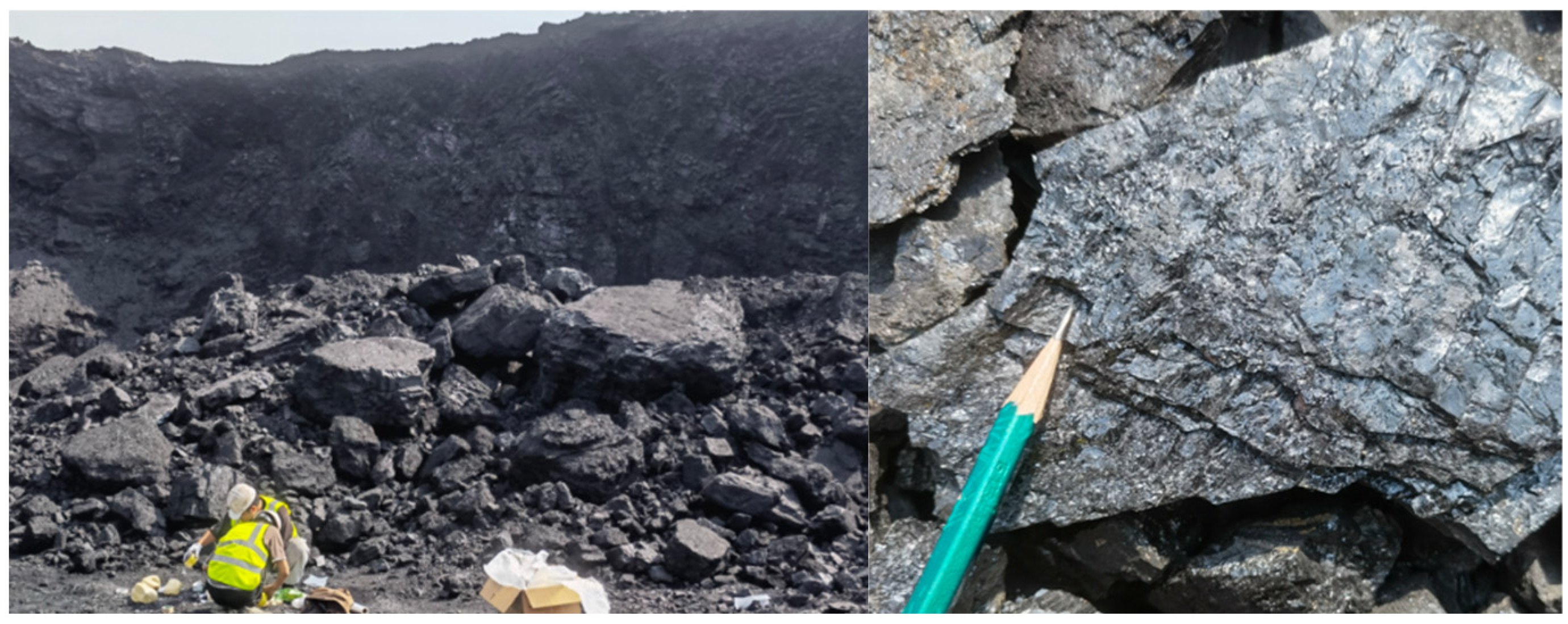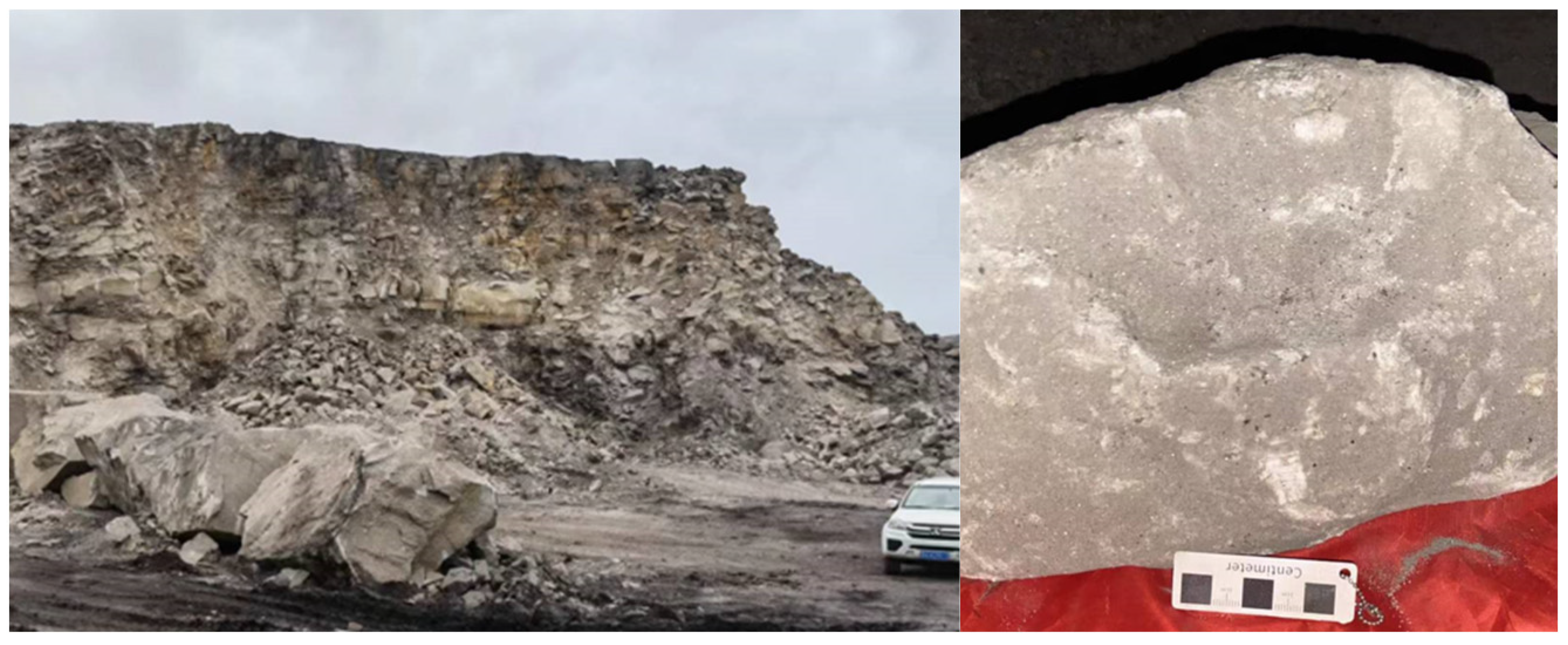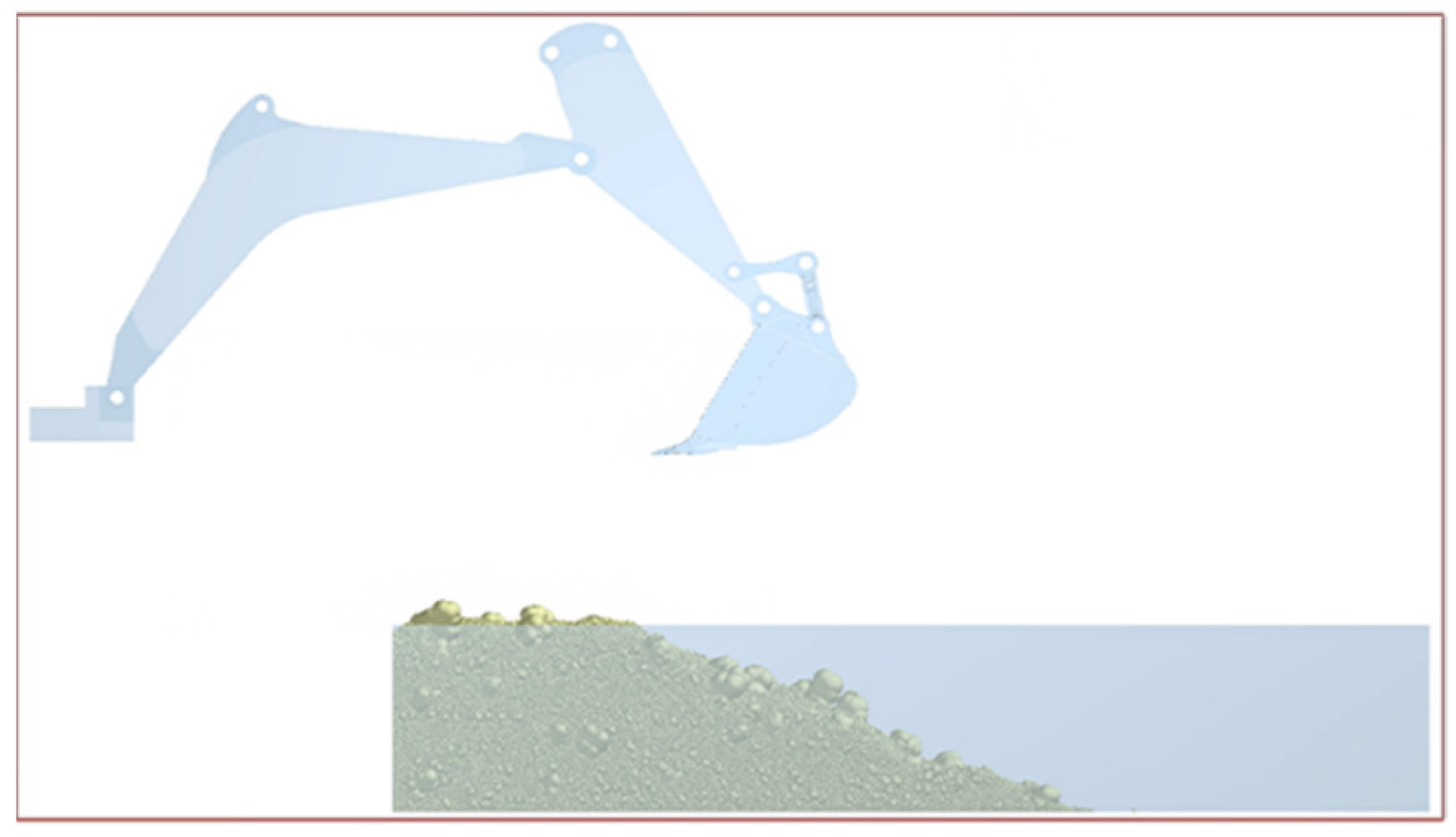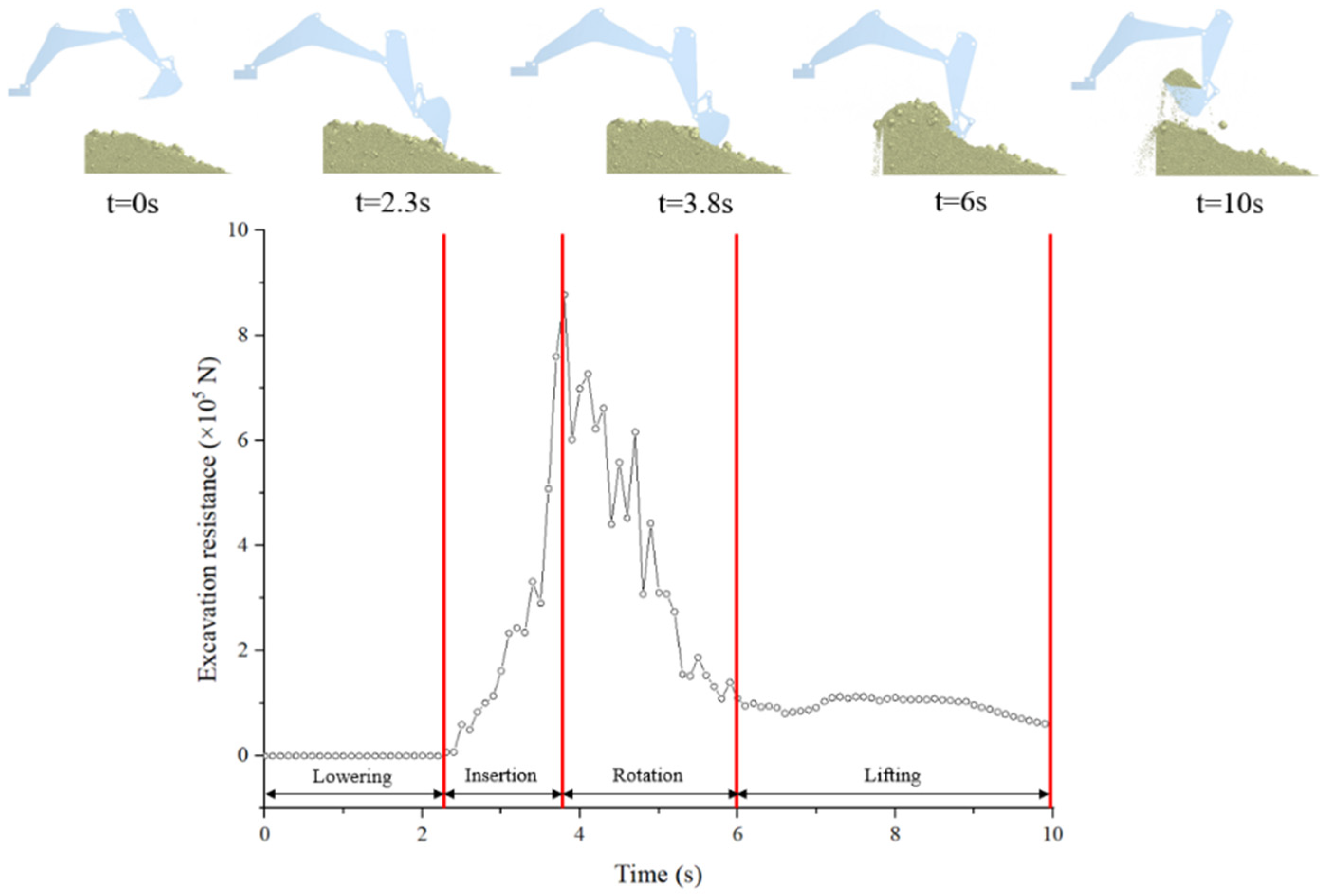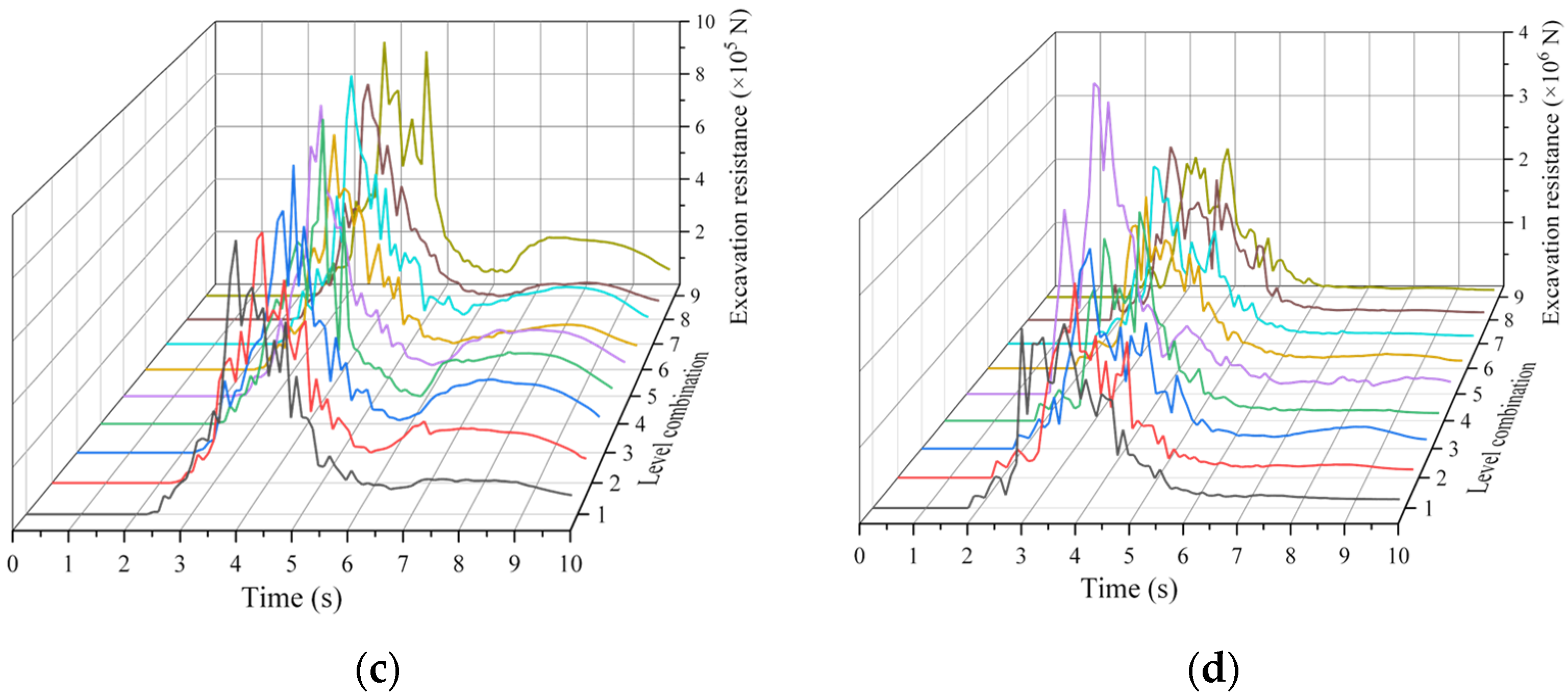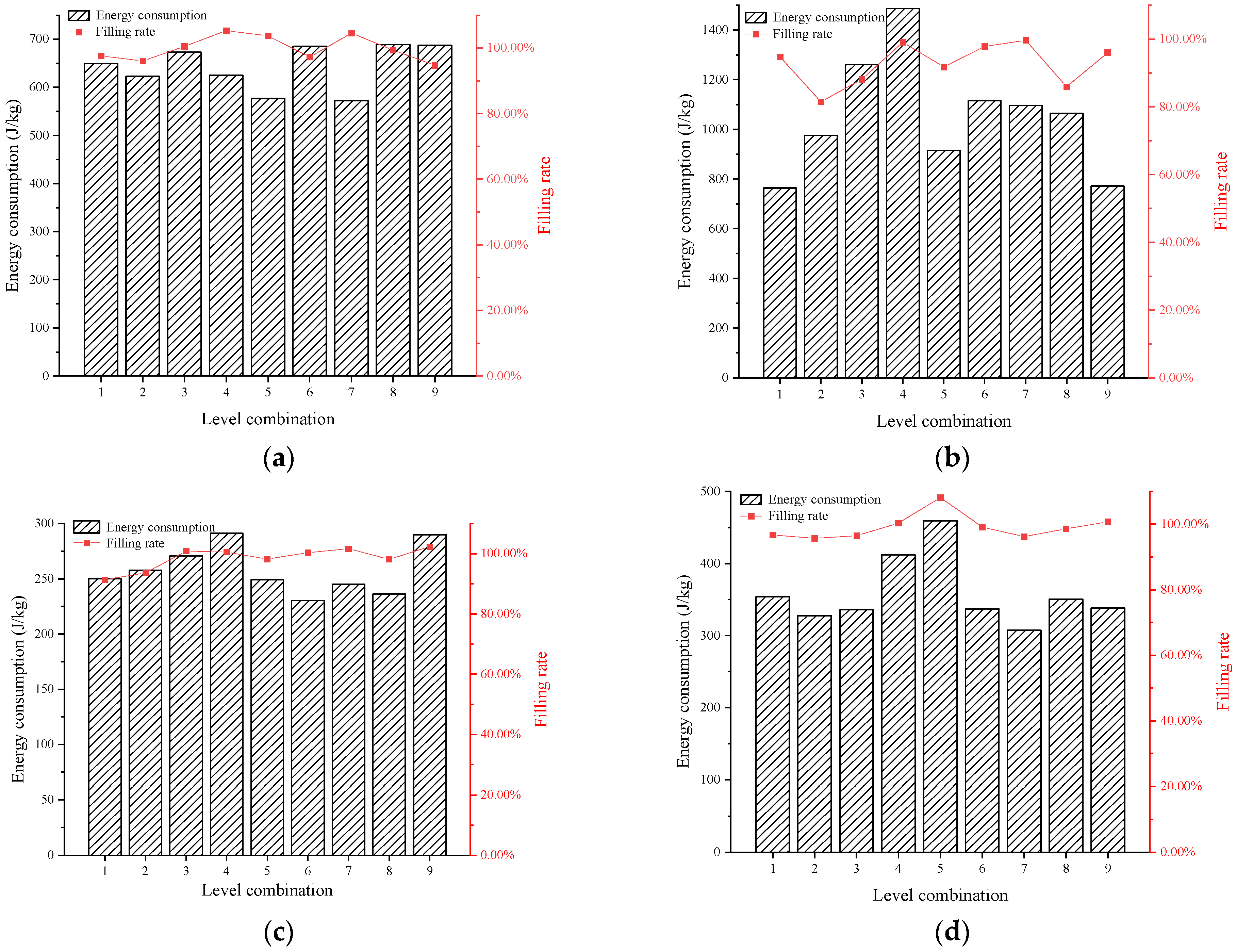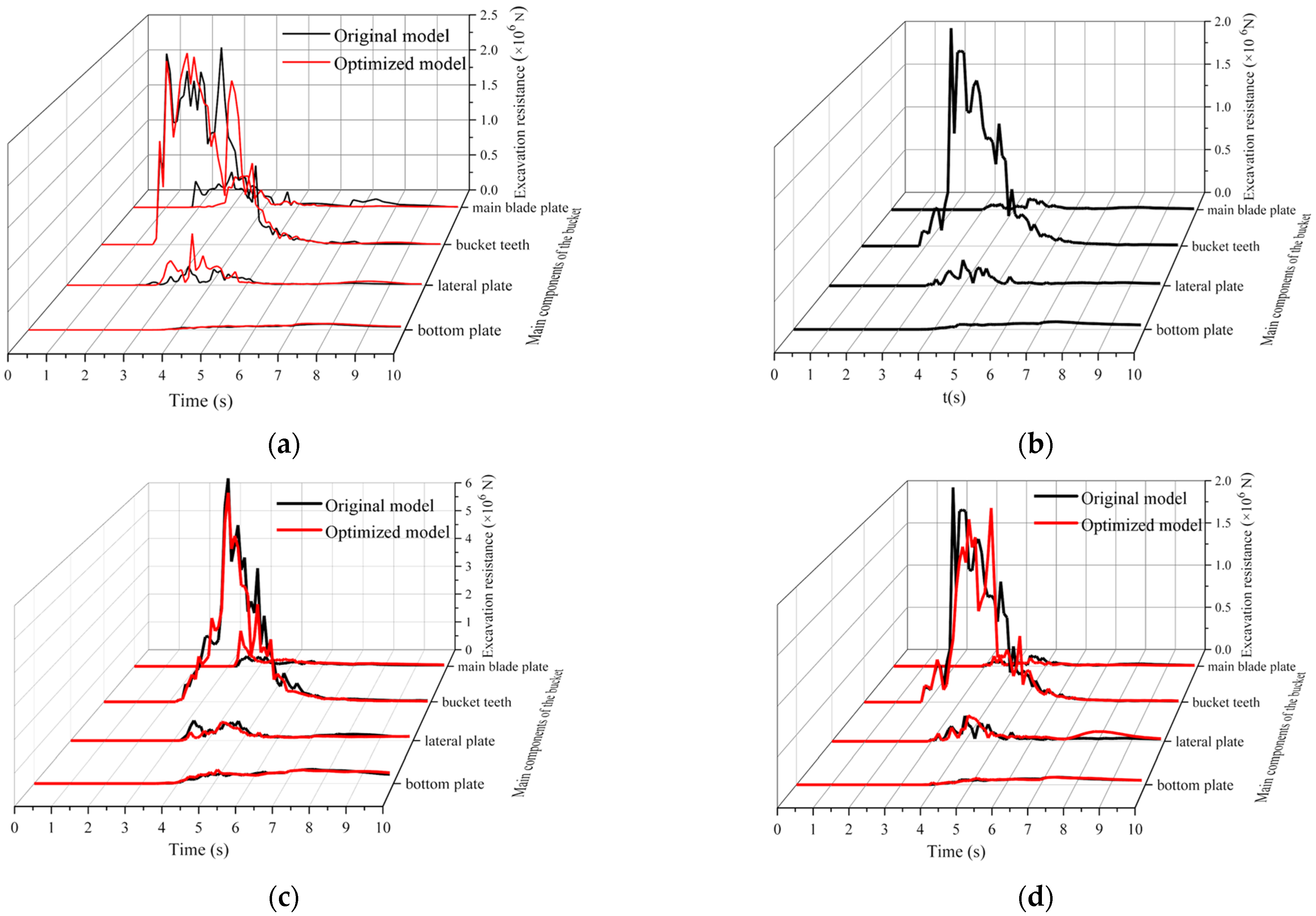1. Introduction
An excavator is the key equipment in mining operations, and the bucket is the core component of an excavator. During the excavation operation, the bucket needs to overcome the excavation resistance formed by its interaction with the material. In addition, the resistance determines the energy consumption during excavator operation. The excavation resistance generally includes the cutting resistance of the material to the bucket teeth and cutting edge, the frictional resistance when the material flows along the bucket bottom plate and side walls and the force generated by overcoming the internal friction of the material. This resistance value varies with the state of the material (texture, moisture content), particle size distribution, thickness of the cutting layer and structural dimensions of the bucket [
1,
2,
3]. At present, there are some problems with excavators such as high excavation resistance, high energy consumption and low filling rate, which greatly limit the working efficiency and service life of excavators. The structural parameters of the bucket can directly affect the excavation resistance and energy consumption of the bucket, so it is necessary to optimize the structural parameters of the bucket, which can reduce the excavation energy consumption and extend the service life of the bucket to a certain extent.
The geological conditions of our country are complicated and diverse, and the kinds of ores are abundant. The ore properties (Poisson ratio, density, shear modulus) in different regions are quite different, which leads to a great difference in the contact properties (collision coefficient of restitution, coefficient of static friction, coefficient of rolling friction) between the bucket and the ore. The excavation performance (excavation resistance, energy consumption and filling rate) of the bucket varies when excavating different ores. The resistance value changes with the state of the material (texture, water content), particle size distribution, bucket structure and size. The cutting resistances of the cutting edge and the bucket teeth are related to the mechanical characteristics of the material, and the friction resistance is related to the internal friction angle of the material, the firmness of the material, the parameters of the bucket teeth and the cutting edge, the cutting edge angle and other factors. Therefore, it is of great significance to optimize the structural parameters of the bucket to improve the excavation performance and service life of the bucket for different excavation conditions.
In recent years, with the development of computer assistive technology, more and more experts and scholars use numerical simulation methods such as finite element method and discrete element method to predict the excavation resistance and optimize the bucket structure. The finite element method (FEM) is a numerical technique for solving approximate solutions to boundary value problems of partial differential equations. When solving the problem, the whole problem region is decomposed, and each subregion becomes a simple part called a finite element. The discrete element method (DEM) is a numerical calculation method mainly used to calculate how a large number of particles move under given conditions. Paul [
4] and Malone [
5] applied the discrete element method to the field of engineering machinery to explore the contact relationship between the excavator bucket and the materials. Nezami et al. [
6] established polyhedral soil particle models and used the discrete element method to explore the interaction between the bucket and the soil. Shmulevich [
7,
8] used the discrete element method to simulate the process of cutting soil with the bucket and analyzed the relationship between blade shape and cutting performance, confirming the superiority of the discrete element method in analyzing the mechanical relationship between soil and bucket. Asaf et al. [
9] analyzed the dynamic interaction between soil and bucket during soil cutting. In order to more accurately utilize EDEM for simulation analysis, parameter measurement experiments were designed. Mootaz et al. [
10] used the finite element method to analyze the interaction between the bucket and the material and considered the dynamic influence of the material. Coetzee et al. [
11,
12,
13] established a discrete element model of the excavator operation process and predicted the impact of different model parameters on the bucket excavation resistance and filling rate by changing the bucket geometric modeling. Gan et al. [
14] used the discrete element method to study and analyze the loading condition of the bucket during the working process of the mining hydraulic excavator, providing a basis for the shape optimization of the bucket.
At present, numerical simulation methods are widely used in the simulation of excavation processes. However, the modeling of ore is relatively simple, such as all ore particles being circular. In actual excavation, ore models are complex and diverse [
15,
16,
17]. In order to simulate the actual excavation process under different geological conditions, the shape and size of the ore models should be as close as possible to the shape and size of actual ores. In addition, the ore parameters in different geological environments are very different, so these parameters should not only rely on the literature, but also be obtained in combination with specific tests. The modeling and parameter settings of ore have a great influence on the simulation results. Therefore, the simplified ore model and the parameters obtained by referring to the previous literature have a great influence on the simulation results.
In order to explore the optimization methods for structural parameters of buckets under different excavation conditions, geological surveys were conducted on some types of ores in Inner Mongolia and Shanxi to obtain the shape characteristics, size distribution, and material properties of different kinds of ores, and the size distribution and mass proportion of different ore particles were set in EDEM. In addition, the static friction coefficient test device, the rolling friction coefficient test device and the collision coefficient of restitution test device were set up to accurately measure the contact parameters between the bucket and the ore and between the ore and the ore.
In this study, an Adams-EDEM coupled simulation method was used to study the influence of bucket structure parameters on the excavation performance (excavation resistance, energy consumption, filling rate) of excavators under different geological conditions. Additionally, the orthogonal experimental method was used to obtain the optimal parameters combinations of bucket structure, achieving optimization of the excavator bucket structure for different geological conditions.
3. Results and Discussion
The excavation performance of an excavator usually includes excavation resistance, excavation energy consumption and filling rate of the bucket. Based on the orthogonal experiment table, the influence of bucket structure on excavation performance was investigated under different geological conditions.
3.1. Excavation Resistance
In order to explore the trend in excavation resistance of the bucket during the excavation process, the excavation resistance of the original bucket model during the process of excavating Shanxi coal was obtained via EDEM. The trend of the overall excavation resistance of the bucket during the excavation process is shown in
Figure 12. The entire excavation process can be divided into four stages. Within 0 s to 2 s, the arm is lowered and the bucket is not in contact with the ore material, so the value of excavation resistance is zero. Within 2 s to 4 s, the bucket begins to come into contact with the ore material and needs to overcome the adhesion between ore particles. As the depth of the bucket inserted into the ore material pile increases, the excavation resistance also increases. Until most of the space in the bucket is filled with ore material, the excavation resistance begins to decrease. Within 4 s to 6 s, the bucket rod stops moving and the bucket rotates around the bucket rod. The ore material has a high fluidity in the bucket, which can cause a certain impact on the bucket, resulting in significant fluctuations in excavation resistance. However, overall, the excavation resistance of the ore material to the bucket gradually decreases. Within 6 s to 10 s, the arm is lifted and the bucket is filled with the ore material. At the beginning, due to the simultaneous movement of the arm and the bucket, the excavation resistance of the bucket fluctuates. Subsequently, the bucket begins to detach from the ore material pile, and the contact between the bucket and the ore material pile gradually decreases, resulting in a continuous decrease in excavation resistance. After the bucket completely detaches from the ore material pile, the force on the bucket is the gravity of the ore material in the bucket. A small amount of ore material falls from the bucket, resulting in a slight decrease in excavation resistance, but the overall trend of change is stable.
Figure 13 shows the comparison of excavation resistance when the structural parameters of the bucket are different level combinations. Under different geological conditions, the variation trends of excavation resistance of buckets with time are roughly similar and can be divided into four stages. During the lifting stage of the bucket, except for Shanxi coal, the excavation resistance of the bucket is relatively stable and does not fluctuate significantly under the other three geological conditions. Mainly due to the large gap between the coal particles in Shanxi coal, there are phenomena such as ore material flow and collapse during the lifting of the bucket, which causes a certain impact on the bottom plate and lateral plates of the bucket, resulting in the excavation resistance of the bucket showing a trend of first increasing and then decreasing. In addition, the parameter combinations of the bucket structure corresponding to the minimum excavation resistance of the bucket under different geological conditions are different. When excavating Mengdong mudstone, Shanxi gritstone, Shanxi coal and Wuhai mudstone, the parameter combinations of the bucket structure corresponding to the minimum excavation resistance are combination 7, combination 1, combination 6 and combination 9.
3.2. Filling Rate and Energy Consumption
The calculation formula for the filling rate of the bucket is:
where
η is the filling rate,
V1 is the actual volume of material loaded by the bucket and
V is the capacity of the bucket.
The calculation formula for energy consumption of excavating per unit mass of material by the bucket is:
where
E is the energy consumption,
t is the excavation time,
Fp is the horizontal excavation resistance of the material to the bucket during the excavation process,
Fl is the vertical excavation resistance of the material to the bucket during the excavation process,
vp is the horizontal speed of the bucket during excavation process and
vl is the vertical speed of the bucket during excavation process.
Figure 14 shows the comparison of energy consumption of excavating per unit mass of ore material by the bucket and filling rate when the structural parameters of the bucket are different level combinations. Combined with the excavation resistance of the bucket under different structural parameter combinations, the parameter combinations of bucket structure corresponding to the optimal excavation performance (low excavation resistance and energy consumption, high filling rate) under different geological conditions were selected. When excavating Mengdong mudstone, Shanxi gritstone, Shanxi coal and Wuhai mudstone, the parameter combinations of the bucket structure corresponding to the optimal excavation performance were combination 7, combination 1, combination 6 and combination 9. The optimal parameter combinations of the bucket structure under different geological conditions were obtained by comprehensively considering the excavation performance of the bucket (including excavation resistance, energy consumption and filling rate), as shown in
Table 7.
3.3. Excavation Resistance of the Main Components of the Bucket
To compare the excavation resistance before and after optimizing the structure of the bucket, the main load-bearing components of the bucket (
Figure 15), including the bottom plate, lateral plate, bucket teeth and blade plate, were selected for comparative analysis of excavation resistance.
Figure 16 shows the comparison of the excavation resistance of the main load-bearing components before and after the optimization of the bucket structure under different geological conditions. Among them, the optimal bucket model for mining Shanxi coal is the original model of the bucket. During the excavation process, the bucket teeth first come into contact with the ore material. As the main load-bearing component, the bucket teeth are subjected to the greatest excavation resistance. As the excavation progresses, the blade plate and lateral plates of the bucket come into contact with the ore material. The bucket teeth are installed on the blade plate, and the excavation resistance suffered by the bucket teeth is transmitted to the blade plate. In addition, during the excavation process, the blade plate and lateral plates have the function of assisting in excavating ore materials, so the blade plate and lateral plates are also subjected to significant excavation resistance. However, the excavation resistance of the blade plate and lateral plates is much smaller than that of the bucket teeth. During the excavation process, there are random fluctuations in the excavation resistance of the bucket teeth, blade plate, and lateral plates, mainly due to the inconsistent particle size of the ore material and the fluidity of the ore material. With the filling of the ore materials in the bucket, the excavation resistance of the bottom plate gradually increases. In addition, because the bottom plate only bears the mass of the ore material, the excavation resistance is low and there is no significant fluctuation.
Comparing the excavation resistance of the main load-bearing components before and after the optimization of the bucket structure, it was found that the excavation resistance of the bucket teeth is the highest under different geological conditions. After optimizing the bucket structure, the maximum excavation resistance of the bucket teeth was significantly reduced. Due to the small excavation resistance of the main blade plate, lateral plates and bottom plate of the bucket, the changes in excavation resistance before and after optimization were not significant. The bucket teeth are the most important load-bearing components, and the excavation resistance of the bucket teeth is the highest during the excavation process. Therefore, the bucket teeth are the most easily damaged parts, which affects the work efficiency of the excavator. In addition, the reduction in excavation resistance of the main components of the bucket is beneficial for reduction in stress and deformation during the bucket excavation process, thereby reducing the probability of damage to the bucket and extending its service life.
After structural optimization, the overall excavation resistance and maximum excavation resistance of the bucket are reduced, which can effectively improve the service life of the bucket.
4. Conclusions
In this study, the bucket structure was optimized for different geological conditions based on the orthogonal experimental method and the Adams-EDEM coupled method. The main conclusions are as follows:
Based on the excavation resistance characteristics of the bucket, the excavation process can be divided into four stages: (1) The bucket is lowered without touching the ore material. (2) The bucket continuously inserts ore material. (3) The bucket rotates around the bucket rod to fill with ore material. (4) The bucket is lifted when the bucket is filled with ore material.
According to the orthogonal experimental method, the optimized parameter combinations of bucket structures under different geological conditions were obtained, and it was found that the optimized structure of the bucket is different under different geological conditions. Therefore, it is necessary to optimize the bucket structure for different geological conditions.
Comparing the excavation resistance changes of the main load-bearing components before and after bucket optimization, it was found that the bucket teeth are the main load-bearing components during the excavation process. After structural optimization, the excavation resistance of the bucket teeth is significantly reduced, while the excavation resistance changes of other components of the bucket are relatively small.
In this study, the stress and deformation analysis of the bucket before and after the structural optimization was not carried out to analyze the damaged position of the bucket so as to further optimize the bucket structure. In future research, dynamic, discrete element and finite element methods can be combined to carry out static analysis of the bucket before and after structural optimization. By comparing the stress and deformation of the bucket before and after structure optimization, the structure of the bucket is further improved. In addition, the optimized bucket can be manufactured according to the reduction ratio, sensor technology can be used to monitor the excavation resistance during the excavation process, and the mining energy consumption and filling rate can be calculated to verify the simulation results.

